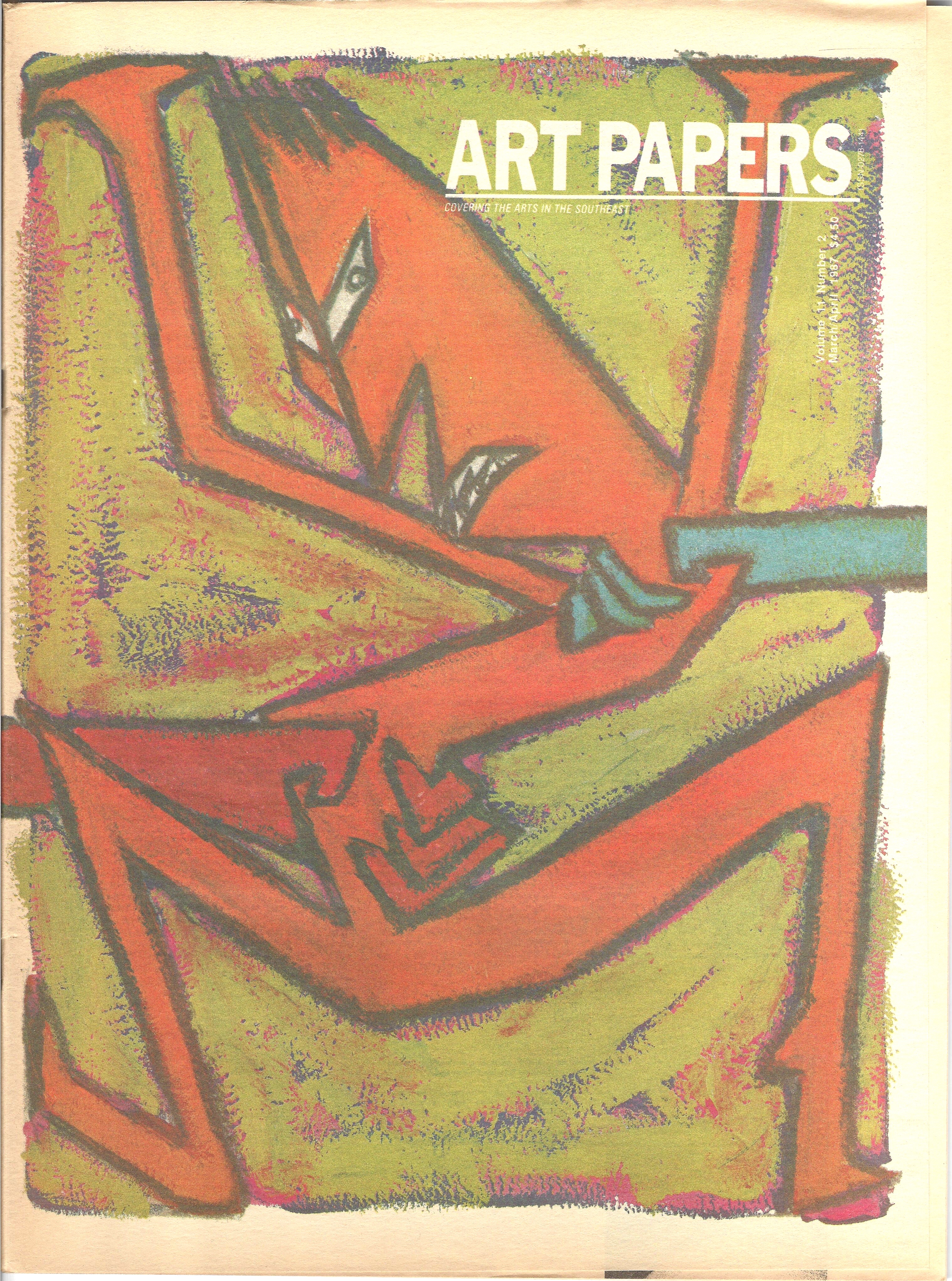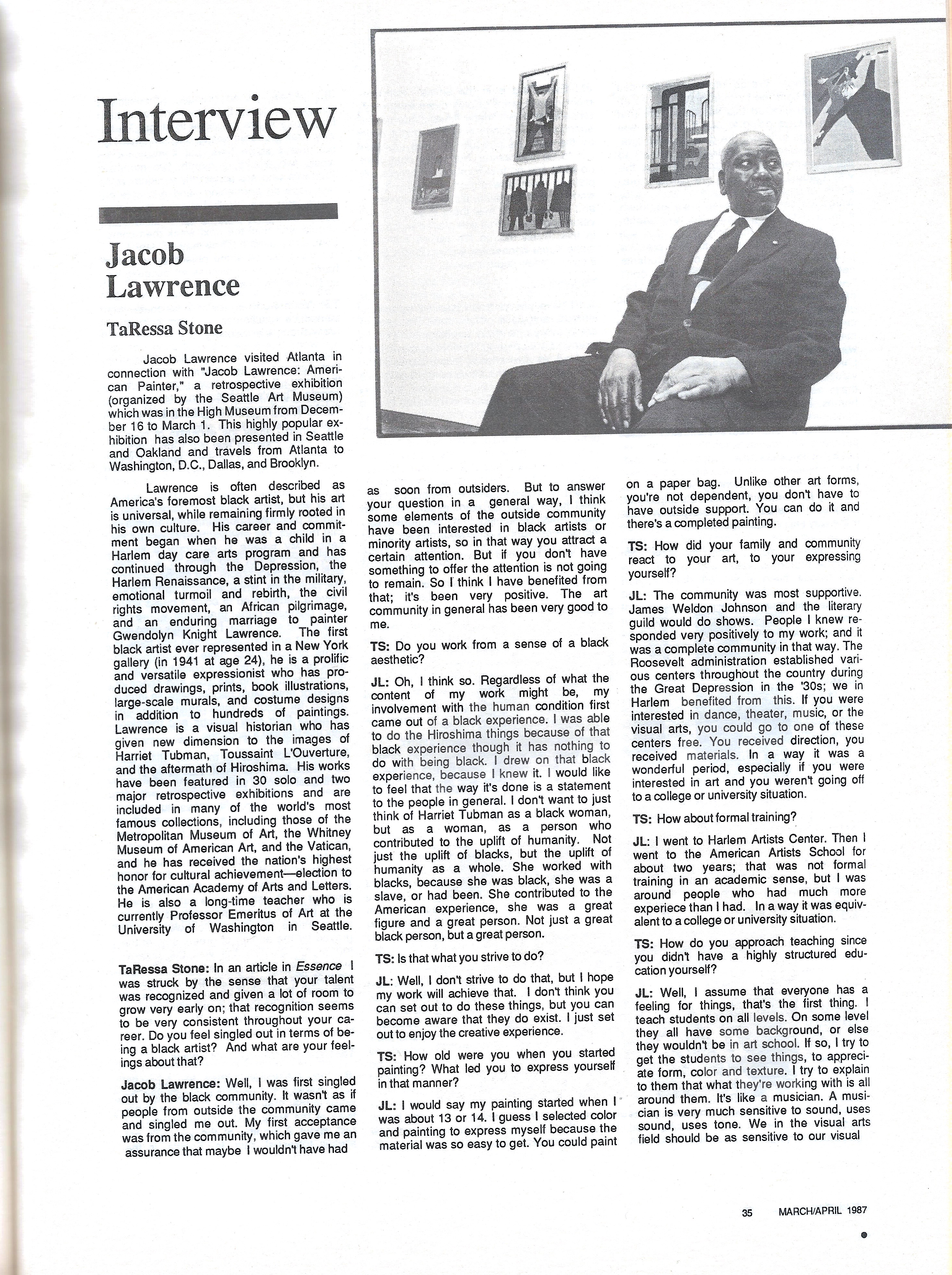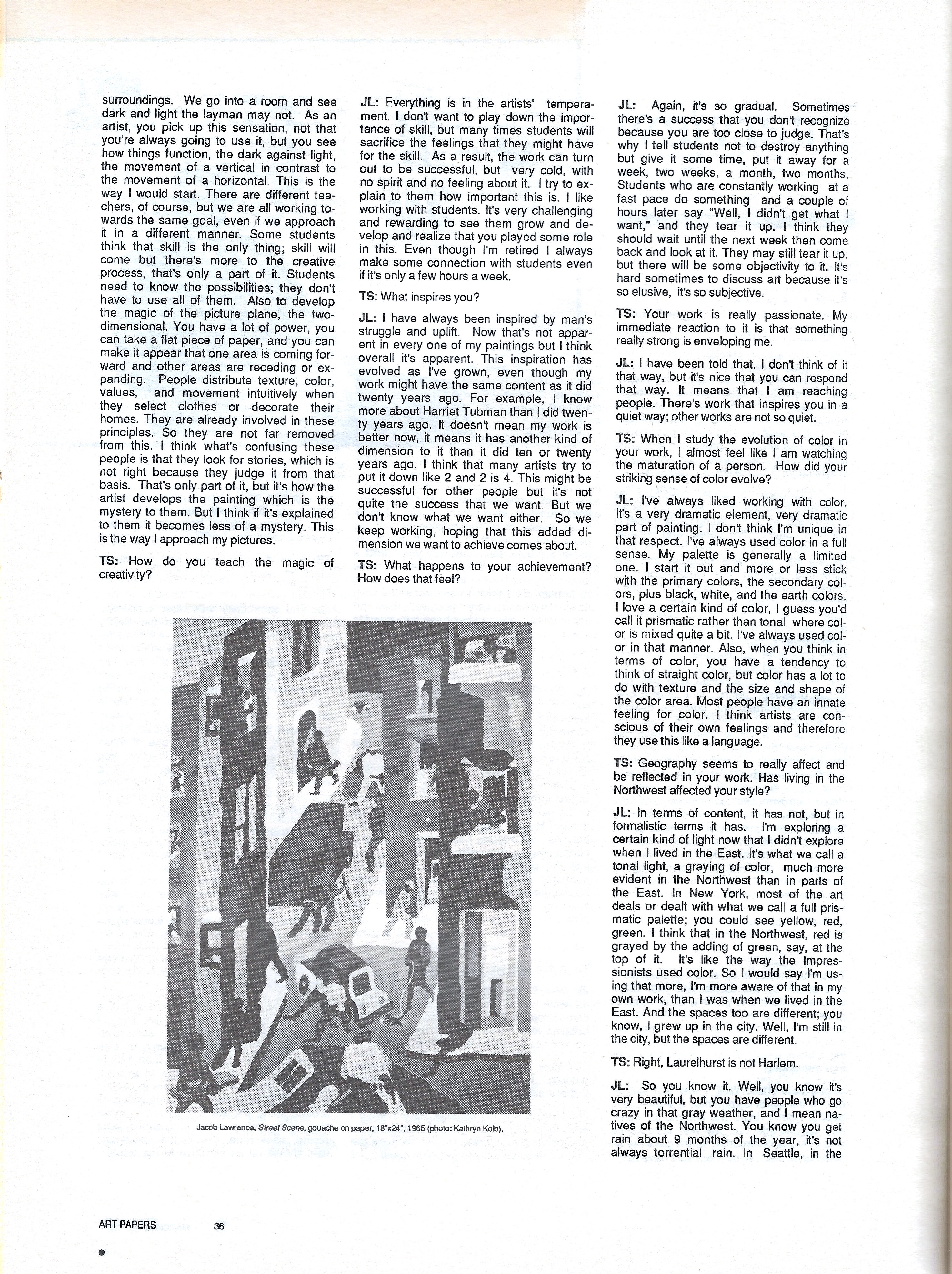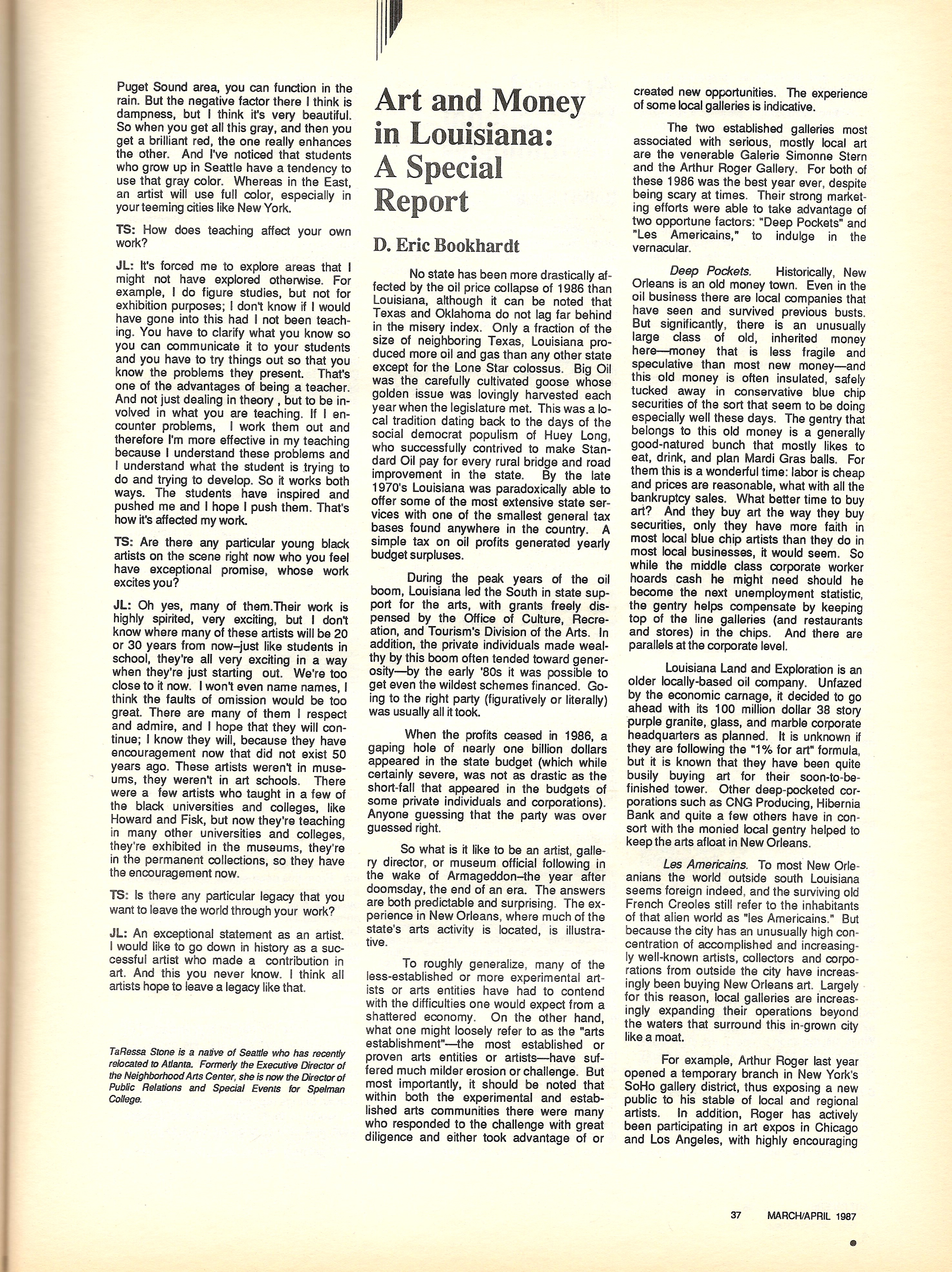Jacob Lawrence
Jacob Lawerence, Street Scene (detail in situ Art Papers issue 11.02), 1965, gouache on paper, 18 x 24 inches
Share:
This interview was originally published in ART PAPERS March/April 1987, Vol 11, issue 2.
Jacob Lawrence visited Atlanta in connection with “Jacob Lawrence: American Painter,” a retrospective exhibition (organized by the Seattle Art Museum) which was in the High Museum from December 16 to March 1. This highly popular exhibition has also been presented in Seattle and Oakland and travels from Atlanta to Washington, D.C., Dallas, and Brooklyn.
Lawrence is often described as America’s foremost black artist, but his art is universal, while remaining firmly rooted in his own culture. His career and commitment began when he was a child in a Harlem day care arts program and has continued through the Depression, the Harlem Renaissance, a stint in the military, emotional turmoil and rebirth, the civil rights movement, an African pilgrimage, and an enduring marriage to painter Gwendolyn Knight Lawrence. The first black artist ever represented in a New York gallery (in 1941 at age 24), he is a prolific and versatile expressionist who has produced drawings, prints, book illustrations, large-scale murals, and costume designs in addition to hundreds of paintings. Lawrence is a visual historian who has given new dimension to the images of Harriet Tubman, Toussaint L’Ouverture, and the aftermath of Hiroshima. His works have been featured in 30 solo and two major retrospective exhibitions and are included in many of the world’s most famous collections, including those of the Metropolitan Museum of Art, the Whitney Museum of American Art, and the Vatican, and he has received the nation’s highest honor for cultural achievement—election to the American Academy of Arts and Letters. He is also a long-time teacher who is currently Professor Emeritus of Art at the University of Washington in Seattle.
TaRessa Stone: In an article in Essence I was struck by the sense that your talent was recognized and given a lot of room to grow very early on; that recognition seems to be very consistent throughout your career. Do you feel singled out in terms of being a black artist? And what are your feelings about that?
Jacob Lawrence: Well, I was first singled out by the black community. It wasn’t as if people from outside the community came and singled me out. My first acceptance was from the community, which gave me an assurance that maybe I wouldn’t have had as soon from outsiders. But to answer your question in a general way, I think some elements of the outside community have been interested in black artists or minority artists, so in that way you attract a certain attention. But if you don’t have something to offer the attention is not going to remain. So I think I have benefited from that; it’s been very positive. The art community in general has been very good to me.
TS: Do you work from a sense of a black aesthetic?
JL: Oh, I think so. Regardless of what the content of my work might be, involvement with the human condition first came out of a black experience. I was able to do the Hiroshima things because of that black experience though it has nothing to do with being black. I drew on that black experience, because I knew it. I would like to feel that the way it’s done is a statement to the people in general. I don’t want to just think of Harriet Tubman as a black woman, but as a woman, as a person who contributed to the uplift of humanity. Not just the uplift of blacks, but the uplift of humanity as a whole. She worked with blacks, because she was black, she was a slave, or had been. She contributed to the American experience, she was a great figure and a great person. Not just a great black person, but a great person.
TS: Is that what you strive to do?
JL: Well, I don’t strive to do that, but I hope my work will achieve that. I don’t think you can set out to do these things, but you can become aware that they do exist. I just set out to enjoy the creative experience.
TS: How old were you when you started painting? What led you to express yourself in that manner?
JL: I would say my painting started when I was about 13 or 14. I guess I selected color and painting to express myself because the material was so easy to get. You could paint on a paper bag. Unlike other art forms, you’re not dependent, you don’t have to have outside support. You can do it and there’s a completed painting.
TS: How did your family and community react to your art, to your expressing yourself?
JL: The community was most supportive. James Weldon Johnson and the literary guild would do shows. People I knew responded very positively to my work; and it was a complete community in that way. The Roosevelt administration established various centers throughout the country during the Great Depression in the ’30s; we in Harlem benefited from this. If you were interested in dance, theater, music, or the visual arts, you could go to one of these centers free. You received direction, you received materials. In a way it was a wonderful period, especially if you were interested in art and you weren’t going off to a college or university situation.
TS: How about formal training?
JL: I went to Harlem Artists Center. Then I went to the American Artists School for about two years; that was not formal training in an academic sense, but I was around people who had much more experience than I had. In a way it was equivalent to a college or university situation.
TS: How do you approach teaching since you didn’t have a highly structured education yourself?
JL: Well, I assume that everyone has a feeling for things, that’s the first thing. I teach students on all levels. On some level they all have some background, or else they wouldn’t be in art school. If so, I try to get the students to see things, to appreciate form, color and texture. I try to explain to them that what they’re working with is all around them. It’s like a musician. A musician is very much sensitive to sound, uses sound, uses tone. We in the visual arts field should be as sensitive to our visual surroundings. We go into a room and see dark and light the layman may not. As an artist, you pick up this sensation, not that you’re always going to use it, but you see how things function, the dark against light, the movement of a vertical in contrast to the movement of a horizontal. This is the way I would start. There are different teachers, of course, but we are all working towards the same goal, even if we approach it in a different manner. Some students think that skill is the only thing; skill will come but there’s more to the creative process, that’s only a part of it. Students need to know the possibilities; they don’t have to use all of them. Also to develop the magic of the picture plane, the two-dimensional. You have a lot of power, you can take a flat piece of paper, and you can make it appear that one area is coming forward and other areas are receding or expanding. People distribute texture, color, values, and movement intuitively when they select clothes or decorate their homes. They are already involved in these principles. So they are not far removed from this. I think what’s confusing these people is that they look for stories, which is not right because they judge it from that basis. That’s only part of it, but it’s how the artist develops the painting which is the mystery to them. But I think if it’s explained to them it becomes less of a mystery. This is the way I approach my pictures.
TS: How do you teach the magic of creativity?
JL: Everything is in the artists’ temperament. I don’t want to play down the importance of skill, but many times students will sacrifice the feelings that they might have for the skill. As a result, the work can turn out to be successful, but very cold, with no spirit and no feeling about it. I try to explain to them how important this is. I like working with students. It’s very challenging and rewarding to see them grow and develop and realize that you played some role in this. Even though I’m retired I always make some connection with students even if it’s only a few hours a week.
TS: What inspires you?
JL: I have always been inspired by man’s struggle and uplift. Now that’s not apparent in every one of my paintings but I think overall it’s apparent. This inspiration has evolved as I’ve grown, even though my work might have the same content as it did twenty years ago. For example, I know more about Harriet Tubman than I did twenty years ago. It doesn’t mean my work is better now, it means it has another kind of dimension to it than it did ten or twenty years ago. I think that many artists try to put it down like 2 and 2 is 4. This might be successful for other people but it’s not quite the success that we want. But we don’t know what we want either. So we keep working, hoping that this added dimension we want to achieve comes about.
TS: What happens to your achievement? How does that feel?
JL: Again, it’s so gradual. Sometimes there’s a success that you don’t recognize because you are too close to judge. That’s why I tell students not to destroy anything but give it some time, put it away for a week, two weeks, a month, two months, Students who are constantly working at a fast pace do something and a couple of hours later say “Well, I didn’t get what I want,” and they tear it up. I think they should wait until the next week then come back and look at it. They may still tear it up, but there will be some objectivity to it. It’s hard sometimes to discuss art because it’s so elusive, it’s so subjective.
TS: Your work is really passionate. My immediate reaction to it is that something really strong is enveloping me.
JL: I have been told that. I don’t think of it that way, but it’s nice that you can respond that way. It means that I am reaching people. There’s work that inspires you in a quiet way; other works are not so quiet.
TS: When I study the evolution of color in your work, I almost feel like I am watching the maturation of a person. How did your striking sense of color evolve?
JL: I’ve always liked working with color. It’s a very dramatic element, very dramatic part of painting. I don’t think I’m unique in that respect. I’ve always used color in a full sense. My palette is generally a limited one. I start it out and more or less stick with the primary colors, the secondary colors, plus black, white, and the earth colors. I love a certain kind of color, I guess you’d call it prismatic rather than tonal where color is mixed quite a bit. I’ve always used color in that manner. Also, when you think in terms of color, you have a tendency to think of straight color, but color has a lot to do with texture and the size and shape of the color area. Most people have an innate feeling for color. I think artists are conscious of their own feelings and therefore they use this like a language.
TS: Geography seems to really affect and be reflected in your work. Has living in the Northwest affected your style?
JL: In terms of content, it has not, but in formalistic terms it has. I’m exploring a certain kind of light now that I didn’t explore when I lived in the East. It’s what we call a tonal light, a graying of color, much more evident in the Northwest than in parts of the East. In New York, most of the art deals or dealt with what we call a full prismatic palette; you could see yellow, red, green. I think that in the Northwest, red is grayed by the adding of green, say, at the top of it. It’s like the way the Impressionists used color. So I would say I’m using that more, I’m more aware of that in my own work, than I was when we lived in the East. And the spaces too are different; you know, I grew up in the city. Well, I’m still in the city, but the spaces are different.
TS: Right, Laurelhurst is not Harlem.
JL: So you know it. Well, you know it’s very beautiful, but you have people who go crazy in that gray weather, and I mean natives of the Northwest. You know you get rain about 9 months of the year, it’s not always torrential rain. In Seattle, in the Puget Sound area, you can function in the rain. But the negative factor there I think is dampness, but I think it’s very beautiful. So when you get all this gray, and then you get a brilliant red, the one really enhances the other. And I’ve noticed that students who grow up in Seattle have a tendency to use that gray color. Whereas in the East, an artist will use full color, especially in your teeming cities like New York.
TS: How does teaching affect your own work?
JL: It’s forced me to explore areas that I might not have explored otherwise. For example, I do figure studies, but not for exhibition purposes; I don’t know if I would have gone into this had I not been teaching. You have to clarify what you know so you can communicate it to your students and you have to try things out so that you know the problems they present. That’s one of the advantages of being a teacher. And not just dealing in theory, but to be involved in what you are teaching. If I encounter problems, I work them out and therefore I’m more effective in my teaching because I understand these problems and I understand what the student is trying to do and trying to develop. So it works both ways. The students have inspired and pushed me and I hope I push them. That’s how it’s affected my work.
TS: Are there any particular young black artists on the scene right now who you feel have exceptional promise, whose work excites you?
JL: Oh yes, many of them. Their work is highly spirited, very exciting, but I don’t know where many of these artists will be 20 or 30 years from now—just like students in school, they’re all very exciting in a way when they’re just starting out. We’re too close to it now. I won’t even name names, I think the faults of omission would be too great. There are many of them I respect and admire, and I hope that they will continue; I know they will, because they have encouragement now that did not exist 50 years ago. These artists weren’t in museums, they weren’t in art schools. There were a few artists who taught in a few of the black universities and colleges, like Howard and Fisk, but now they’re teaching in many other universities and colleges, they’re exhibited in the museums, they’re in the permanent collections, so they have the encouragement now.
TS: Is there any particular legacy that you want to leave the world through your work?
JL: An exceptional statement as an artist. I would like to go down in history as a successful artist who made a contribution in art. And this you never know. I think all artists hope to leave a legacy like that.
TaRessa Stone is a native of Seattle who relocated to Atlanta. Formerly the Executive Director of the Neighborhood Arts Center, at the time of this interview she was Director of Public Relations and Special Events for Spelman College.



